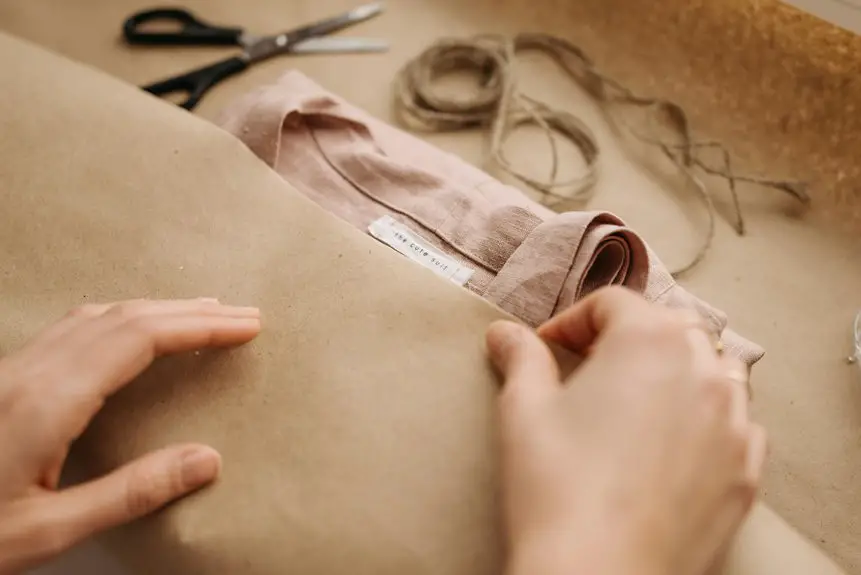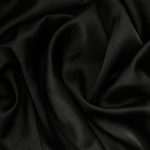You’ll find acetate lining fabric offers a smooth, silky feel that enhances comfort in dresses, suits, and jackets. It’s lightweight, wrinkle-resistant, and drapes elegantly, though it’s sensitive to heat and requires gentle care like hand washing and low-heat pressing. Acetate balances luxury and practicality better than many linings, making your garments look polished while feeling great. If you want to know how to sew it safely and keep your clothes in top shape, keep exploring these tips.
Table of Contents
Key Takeaways
- Acetate lining fabric is a smooth, lightweight, semi-synthetic material with a soft, silky feel that enhances garment comfort.
- It drapes well, resists wrinkles, but is sensitive to heat and moisture, requiring careful handling during sewing and cleaning.
- Commonly used in dresses, jackets, and suits, acetate lining improves comfort, reduces friction, and adds a subtle shine to garments.
- Sewing acetate requires fine pins, tissue stabilization, moderate stitch length, and low-heat pressing with a cloth to avoid damage.
- Clean acetate linings gently by hand washing in cool water, spot cleaning stains carefully, and air drying away from direct heat or sunlight.
What Is Acetate Lining Fabric?
Acetate lining fabric is a smooth, lightweight material commonly used to finish the inside of garments. When you wear clothing with acetate lining, you’ll notice how it feels soft and silky against your skin, offering comfort without adding bulk.
You’ll find acetate lining in dresses, jackets, and suits because it helps garments drape nicely and prevents rough seams from irritating you. This fabric is made from cellulose acetate, derived from natural sources like wood pulp, making it semi-synthetic.
While it looks similar to silk, acetate lining is more affordable and easier to care for. When manufacturers choose acetate, they’re aiming to balance comfort, appearance, and cost-effectiveness in the garment’s interior, ensuring you get a polished finish and a pleasant wearing experience.
Key Characteristics of Acetate Fabric
When you wear garments lined with this fabric, you’ll notice its smoothness and lightweight feel right away.
Acetate fabric has a silky texture that feels comfortable against your skin, making it ideal for linings. It drapes well, allowing your clothes to hang gracefully without added bulk. You’ll appreciate its ability to resist wrinkles, helping your outfits maintain a polished look throughout the day.
While acetate is breathable, it can be less durable than some other fibers, so you’ll want to handle it gently. This fabric also has a subtle sheen, adding a touch of elegance inside your garments.
Keep in mind, acetate can be sensitive to heat and moisture, so care is essential to preserve its quality and appearance.
How Acetate Compares to Other Lining Materials
Although you mightn’t always notice the lining fabric, it plays an essential role in the comfort and appearance of your clothing. When comparing acetate to other linings like polyester, silk, or cotton, you’ll find acetate offers a unique balance.
The lining fabric subtly shapes your clothing’s comfort and look, with acetate offering a distinct, balanced choice.
Here’s how it stacks up:
- Feel and Comfort: Acetate feels smooth and silky, similar to silk, but usually costs less and breathes better than polyester.
- Durability: While not as strong as polyester, acetate resists wrinkles better than cotton and maintains its sheen over time.
- Care Requirements: Acetate requires gentle care, often dry cleaning, whereas polyester is more forgiving, and cotton can be machine washed.
Knowing these differences helps you choose the right lining for both style and function in your garments.
Common Applications of Acetate Lining in Fashion
You’ll find acetate lining often used to boost garment comfort by providing a smooth feel against your skin.
It also helps improve fabric durability, making your clothes last longer.
Plus, acetate adds a subtle shine that enhances the overall look of your fashion pieces.
Enhancing Garment Comfort
Because acetate lining feels smooth against the skin, it greatly boosts the comfort of garments you wear daily.
You’ll notice it reduces friction, preventing irritation when your outfit brushes against your body. Plus, acetate helps your clothes glide on and off easily, which is a huge convenience.
Here are three ways acetate lining enhances your garment comfort:
- Soft Touch: It creates a silky inner surface, making your clothes feel gentle and luxurious.
- Moisture Management: Acetate wicks away sweat, keeping you dry and comfortable throughout the day.
- Temperature Regulation: It helps maintain a balanced temperature, so you don’t feel too hot or cold.
Using acetate lining means your clothes not only look good but feel great too.
Improving Fabric Durability
When you choose garments with acetate lining, you’re also investing in their longevity. Acetate adds a protective layer that reduces friction between outer fabric and skin or underlayers, preventing wear and tear.
This lining helps maintain the garment’s shape by providing structural support, which means less stretching and sagging over time. Because acetate resists wrinkles and creases, your clothes stay looking fresh longer, reducing the need for frequent ironing or dry cleaning that can degrade fabric fibers.
Plus, acetate’s smooth texture minimizes fabric abrasion, extending the life of delicate materials like silk and wool. By opting for acetate-lined clothing, you guarantee your wardrobe remains durable and retains its quality, making it a smart choice for everyday wear and special occasions alike.
Adding Aesthetic Appeal
Beyond enhancing durability, acetate lining also elevates the look and feel of your garments.
It adds a smooth, lustrous finish that makes fabrics glide effortlessly over your skin, boosting comfort and style. When you choose acetate lining, you’re not just improving function—you’re enhancing fashion.
Here are three ways acetate lining adds aesthetic appeal:
- Sleek sheen: Acetate’s natural shine gives your garments a polished, luxurious look.
- Rich colors: The lining holds dyes well, letting you enjoy vibrant, lasting hues inside your clothes.
- Soft texture: Its silky feel enhances the overall tactile experience, making your outfit more pleasant to wear.
Advantages of Using Acetate for Linings
When you choose acetate for linings, you get a smooth texture that feels comfortable against your skin.
It also resists moisture, helping garments stay fresh and durable.
These benefits make acetate a smart option for high-quality clothing linings.
Smooth Texture Benefits
Acetate lining offers a smooth texture that feels soft against your skin, making garments more comfortable to wear. This silky feel reduces friction between your clothes and skin, preventing irritation throughout the day.
When you choose acetate linings, you also benefit from:
- Enhanced Draping: The smooth surface allows fabric to flow gracefully, improving your garment’s overall fit and silhouette.
- Easy Dressing: Sliding into clothes is simpler because acetate linings reduce resistance, saving you time and effort.
- Luxurious Appearance: The shiny, smooth finish adds a subtle elegance to your clothing, elevating its aesthetic appeal.
Moisture Resistance Properties
How does moisture resistance impact your clothing’s comfort? When you wear garments lined with acetate, you’ll notice they handle moisture better than many other fabrics.
Acetate resists absorbing sweat and humidity, which helps keep you feeling dry and fresh throughout the day. This property prevents dampness from clinging to your skin, reducing discomfort and irritation.
Plus, acetate’s moisture resistance helps protect the garment’s structure by minimizing water absorption, which can cause fabric to sag or lose shape.
Potential Drawbacks of Acetate Fabric
Although acetate fabric offers a smooth and luxurious feel, you should be aware of some potential drawbacks before choosing it for your garments. Understanding these limitations helps you make informed decisions.
- Low Heat Resistance: Acetate can melt or scorch easily when exposed to high temperatures, so you need to be cautious with ironing or drying.
- Poor Moisture Absorption: It doesn’t wick moisture well, which might leave you feeling uncomfortable in hot or humid conditions.
- Prone to Wrinkling and Static: Acetate wrinkles easily and can generate static cling, causing your garment to lose its sleek appearance quickly.
Tips for Sewing With Acetate Lining
When working with acetate lining, you’ll want to use sharp needles and fine thread to prevent snagging the delicate fabric.
Pin your fabric carefully, using fine, sharp pins or clips, to avoid leaving holes or runs. Since acetate can shift easily, consider stabilizing it with tissue paper underneath while sewing.
Keep your stitch length moderate to avoid puckering; around 2.5 to 3 mm works well. Press seams with a low heat setting and a pressing cloth to prevent melting or shining.
Avoid using steam directly on acetate, as it can damage the fibers. Finally, test your machine settings on a scrap piece before starting your project to guarantee smooth stitching and to prevent any surprises.
Following these tips will help you sew acetate lining smoothly and professionally.
Proper Cleaning Methods for Acetate Linings
Since acetate linings are delicate and prone to damage, you need to handle their cleaning with care.
Avoid harsh detergents and high temperatures to keep the fabric intact. Instead, follow these proper cleaning methods:
- Hand wash gently — Use cool water and a mild detergent. Swirl the garment softly and avoid wringing to prevent distortion.
- Spot clean stains — Dab with a soft cloth and mild solution immediately. Blot, don’t rub, to protect the fibers.
- Air dry flat — Lay the garment on a clean towel away from direct sunlight or heat sources to avoid shrinking or warping.
Storing Garments With Acetate Lining
Properly storing garments with acetate lining helps preserve their shape and extend their lifespan.
You should hang these garments on padded or wide wooden hangers to prevent stretching or distortion. Avoid wire hangers, which can cause misshaping.
Keep the garments in a cool, dry place away from direct sunlight; acetate is sensitive to heat and can discolor or weaken over time.
If you need to fold the garment, place tissue paper inside to minimize creases.
Also, make sure your storage area is well-ventilated to prevent moisture buildup, which can damage the acetate lining.
Finally, avoid overcrowding your closet to reduce friction and wrinkles, ensuring your acetate-lined pieces stay in excellent condition longer.
Innovations and Trends in Acetate Fabric Use
Taking care of garments with acetate lining is just one part of appreciating this versatile fabric.
You’ll be excited to know that innovations in acetate use are shaping modern fashion and textiles. Here are three trending developments you should watch:
- Eco-friendly Production – New processes reduce environmental impact, making acetate fabric more sustainable and appealing to eco-conscious consumers like you.
- Blended Fabrics – Designers blend acetate with natural fibers to enhance durability and comfort without sacrificing its luxurious feel.
- Smart Textiles – Incorporating acetate in smart fabrics improves breathability and moisture management, ideal for activewear and high-performance clothing.
Frequently Asked Questions
Is Acetate Lining Fabric Environmentally Friendly?
You shouldn’t expect acetate lining fabric to be very eco-friendly since it’s made from wood pulp but involves chemical processing. You can reduce impact by choosing recycled acetate or using it sparingly in your projects.
Can Acetate Lining Cause Allergic Reactions?
Don’t panic—acetate linings won’t turn you into a walking rash! While rare, some folks can get mild irritation or allergies. If your skin’s sensitive, test a small patch before wearing it all day.
How Does Acetate Lining Fabric Affect Garment Breathability?
Acetate lining fabric reduces garment breathability because it’s less porous than natural fibers. You’ll find it feels smooth and silky, but it can trap heat and moisture, making your clothes less comfortable in warm conditions.
What Is the Cost Range of Acetate Lining Fabric?
You know what they say, “You get what you pay for.” Acetate lining fabric usually costs between $5 and $15 per yard, depending on quality and brand. You’ll find affordable options without compromising style or comfort.
Are There Any Sustainable Alternatives to Acetate Lining?
You can explore sustainable alternatives like Tencel, organic cotton, or recycled polyester for lining fabric. These options reduce environmental impact and still offer smoothness and durability, making them great eco-friendly choices for your garments.
- Does Chiffon Fabric Stink - July 15, 2025
- Does Chiffon Fabric Affect the Economy - July 15, 2025
- Does Cotton Fabric Have a Nap - July 15, 2025







